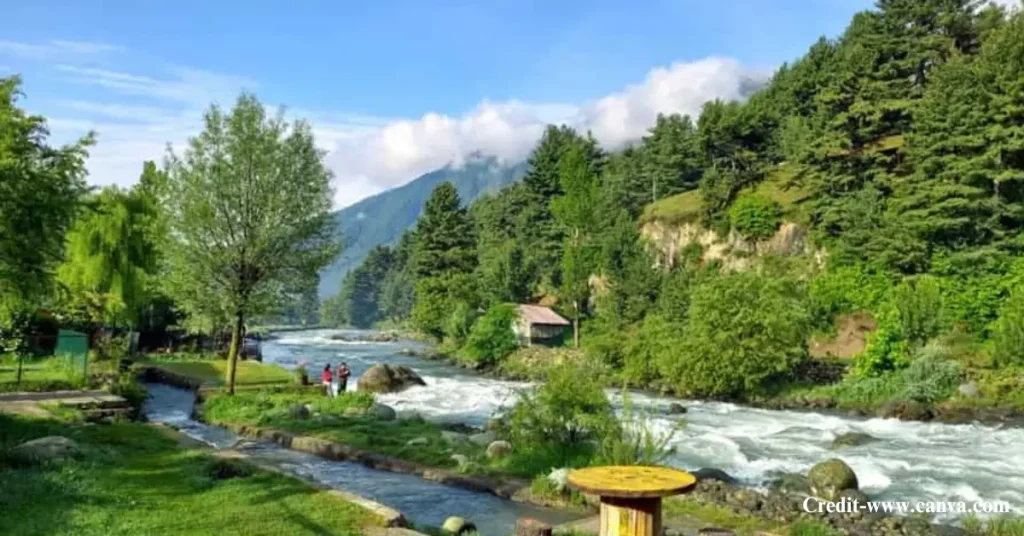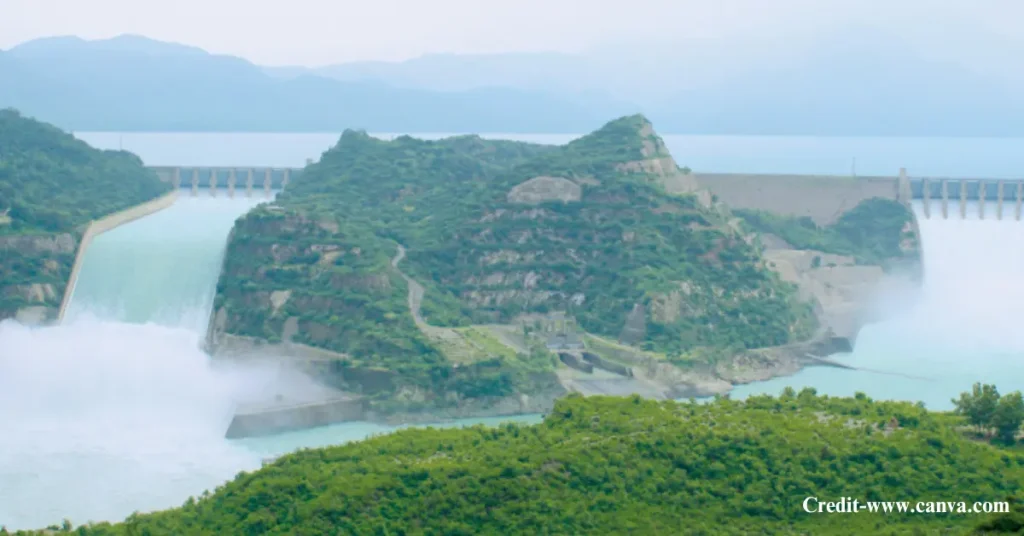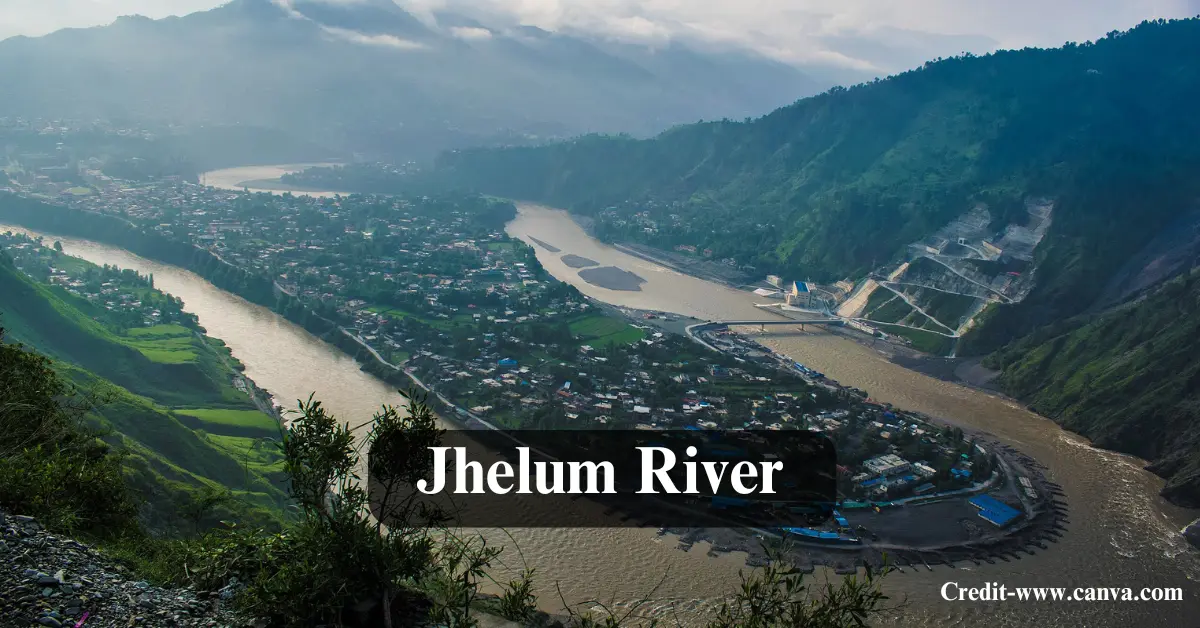The Jhelum River has seen rulers, fights, along with dams, and people have protested its water. It begins in the cold springs of Verinag in Kashmir. The river then meets the Chenab River in Punjab. The Jhelum provides water, plus it shows a part of the history, culture, and life in Pakistan, in addition to India.
In 2025, climate problems grow, and water politics appear in the news often. The Jhelum still moves, sometimes quietly through valleys, and at other times in large waves through dams. A traveller who wants to learn, a person who likes history, or someone who worries about water problems can hear a story from the Jhelum.
Table of Contents

Where It Starts and What It’s Been Called
The Jhelum River starts at Verinag Spring. The spring sits in the Pir Panjal Range in Jammu, in addition to Kashmir. Big chinar trees and hills covered with snow stand around the spring. The area is quiet and calm, so people should visit if they are near. But the river did not always have the name Jhelum.
Ancient Hindu texts refer to the river as Vitasta. Some believe the goddess Parvati created it to clean the Kashmir Valley. The Greeks named the river Hydaspes – it bears historical importance as the Battle of Hydaspes happened there. Alexander the Great defeated King Porus in that fight. In Kashmir, people still call it Vyeth.
The River’s Journey
The Jhelum River runs for about 725 kilometres – it begins at Verinag and flows through the Kashmir Valley, passing towns such as Anantnag and Srinagar. The river then goes into Wular Lake, a large freshwater lake in South Asia, plus enters Pakistan-administered Kashmir.
The Neelum River (Kishanganga) and the Kunhar River join it. It then moves into Punjab, Pakistan. The river passes the Mangla Dam, and it meets the Chenab River near Trimmu.
Wular Lake’s Role in the River’s Flow
Wular Lake plays a big part in steadying the Jhelum – it soaks up extra rain. This helps prevent floods. The lake also houses many birds and fish.
But sadly, pollution and waste from nearby towns have made the lake dirty and smaller. People used to fish here, but now they catch much less. Cleaning up this lake is needed—not just for wildlife, but for everyone living around the Jhelum.
Mangla Dam and Other Big Projects
Pakistan built the Mangla Dam in the 1960s. The dam is an important earth filled structure in the area – it manages floods, and it supplies water to farms. The dam generates power. The dam contains more than 7 million acre feet of water, and it supports crops throughout Punjab.
Over the years, the dam gathered mud plus soil. This reduces how much water it holds. People also spoke about the effect it has on the land downstream.
The Neelum-Jhelum Hydropower Project is another large undertaking – this project sends the Neelum River below the ground through a tunnel to the Jhelum. It adds about 1,000 megawatts to Pakistan’s power. But some groups worry it could hurt the environment.
Other main setups on the river include:
- Uri Hydropower Projects I & II
- Rasul Barrage
- Upper Jhelum Canal
- Chashma–Jhelum Link Canal
These setups help with power, flood safety, and farming, but they also change the river’s natural flow.
Climate Change Is Making Things Worse
The Jhelum River now feels the strain from climate change. In 2025, scientists spoke about unusual rain and snow melt that moved at a quicker rate. Landslides also occurred in the mountains near the river.
Over 900,000 hectares in the river area face danger from landslides. A slide can stop the water and hurt houses. Floods plus dry spells happen more often. When rain falls, it comes in large amounts. But when it is dry, it stays dry for many weeks.
The setups assist with power production, prevent floods, and allow farming; they also alter the river’s usual flow.
Life in Srinagar: The River’s Human Side
In Srinagar, the Jhelum River runs as part of local life. The river goes through the city’s middle – it passes under many old bridges, such as the Zero Bridge. The wooden bridge served pedestrians. Workers constructed it in the 1950s.
- Amira Kadal
- Habba Kadal
- Zaina Kadal
Locals ride in shikaras, live on houseboats, drink tea by the banks, and take evening walks with family. This is where the river becomes most alive—not through numbers or plans, but through people and their daily moments.
Battle of Hydaspes: A River of War
The Battle of Hydaspes happened in 326 BCE and changed the river’s history. Alexander the Great crossed the river during the monsoon. The water level rose, plus the banks became slippery.
He fought King Porus in a brutal battle. People say Alexander’s horse, Bucephalus, died there, along with Alexander. Later, Alexander named a city Bucephala to remember it. The town probably stood near today’s Jalalpur Sharif, Pakistan.
Water Disputes: Jhelum in Politics
In 1960, India, in addition to Pakistan, put their names on the Indus Waters Treaty. The agreement stated India could utilise the Jhelum, Chenab, and Indus Rivers with limits, such as for small farms or power projects. However, held most of the water rights.
The treaty generally functioned well, but in recent times, relations grew tense. In early 2025, a sudden water release from the Uri Dam caused worry about floods in parts of Pakistan. Farmers in Punjab, besides Sindh, voiced concerns that water was kept back or came out too quickly.
Some called it “water warfare.” With rising populations, electricity needs, and climate stress, the river is becoming part of a bigger power game between countries.
Fishing, Farming, and Local Life
Locals use the Jhelum River daily. Years ago, fishermen took in enough fish to feed their families and sell at markets. But pollution plus fewer fish now causes a problem.
Farmers need the Jhelum’s water to grow wheat and rice. The river carries water to fields, similar to the Upper Jhelum Canal. When the water level is low or if the water moves too fast, it can damage all harvests.
A further concern involves sand and gravel mining. People dig next to the riverbanks, which loosens the soil and changes where the river flows.
Travel and Adventure on the Jhelum
The Jhelum River has issues, but people still visit it. Travellers find several activities to do
- They ride a shikara in Srinagar, particularly at sunset.
- A person may boat on Wular Lake.
- Visitors go to Verinag Spring for a calm rest in the hills.
- People walk over the old bridges of the city.
- They hike through the Lidder or Neelum Valleys.
Tourism supplies money to local people, but managers need better rules and plans to protect nature.
Saving the River: What Needs to Happen
Solving the Jhelum’s problems involves more than constructing dams or signing agreements. It also means:
- Planting trees in places likely to slide
- Building water cleaning plants
- Making proper flood plans
- Getting India and Pakistan to talk and work together
- Teaching people to be eco-friendly tourists and careful water users
The Jhelum has given so much for so long. It’s time we gave something back.

Final Thoughts
The Jhelum River does more than appear on a map or provide water – it is part of legends, battles, songs, along with daily routines. From the old stories of Vitasta to Alexander’s fights and the farmers who wait for its water, the river has always been present.
In 2025, it will still move. It still helps. The river still asks people to notice it.
If people respect the river, guard it as well as plan well, the Jhelum will continue to flow for many generations.

